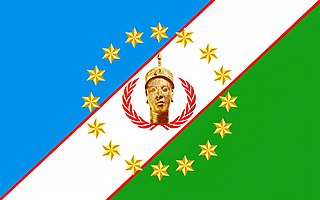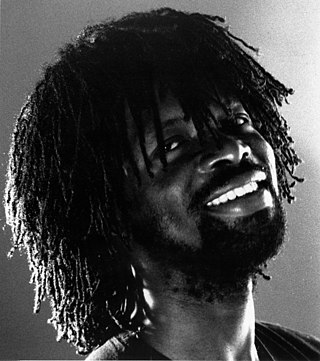In folklore, crossroads may represent a location "between the worlds" and, as such, a site where supernatural spirits can be contacted and paranormal events can take place. Symbolically, it can mean a locality where two realms touch and therefore represents liminality, a place literally "neither here nor there", "betwixt and between".

Orishas are divine spirits that play a key role in the Yoruba religion of West Africa and several religions of the African diaspora that derive from it, such as Cuban, Dominican and Puerto Rican Santería and Brazilian Candomblé. The preferred spelling varies depending on the language in question: òrìṣà is the spelling in the Yoruba language, orixá in Portuguese, and orisha, oricha, orichá or orixá in Spanish-speaking countries.

Yoruba is a language spoken in West Africa, primarily in Southwestern and Central Nigeria. It is spoken by the ethnic Yoruba people. The number of Yoruba speakers is roughly 45 million, plus about 2 million second-language speakers. As a pluricentric language, it is primarily spoken in a dialectal area spanning Nigeria, Benin, and Togo with smaller migrated communities in Côte d'Ivoire, Sierra Leone and The Gambia.

The Yoruba religion, West African Orisa (Òrìṣà), or Isese (Ìṣẹ̀ṣe), comprises the traditional religious and spiritual concepts and practice of the Yoruba people. Its homeland is in present-day Southwestern Nigeria, which comprises the majority of Oyo, Ogun, Osun, Ondo, Ekiti, Kwara and Lagos States, as well as parts of Kogi state and the adjoining parts of Benin and Togo, commonly known as Yorubaland.

The Black Arts Movement (BAM) was an African American-led art movement that was active during the 1960s and 1970s. Through activism and art, BAM created new cultural institutions and conveyed a message of black pride. The movement expanded from the incredible accomplishments of artists of the Harlem Renaissance.
This is a history of aesthetics.

Robert Farris Thompson was an American art historian and writer who specialized in Africa and the Afro-Atlantic world. He was a member of the faculty at Yale University from 1965 to his retirement more than fifty years later and served as the Colonel John Trumbull Professor of the History of Art. Thompson coined the term "black Atlantic" in his 1983 book Flash of the Spirit: African and Afro-American Art and Philosophy – the expanded subject of Paul Gilroy's book The Black Atlantic.
While the African continent is vast and its peoples diverse, certain standards of beauty and correctness in artistic expression and physical appearance are held in common among various African societies.

Babalú-Aye, Oluaye, Ṣọpọna, Ayé in Trinidad Orisha, or Obaluaiye, is one of the orishas or manifestations of the supreme creator god Olodumare in the Yoruba religion of West Africa. Babalú-Aye is the spirit of the Earth and strongly associated with infectious disease, and healing.
Oba means "ruler" in the Yoruba and Bini languages. Kings in Yorubaland, a region which is in the modern republics of Benin, Nigeria and Togo, make use of it as a pre-nominal honorific. Examples of Yoruba bearers include Oba Ogunwusi of Ile-Ife, Oba Aladelusi of Akure, and Oba Akiolu of Lagos. An example of a Bini bearer is Oba Ewuare II of Benin.

The Yoruba of West Africa are responsible for a distinct artistic tradition in Africa, a tradition that remains vital and influential today.
Coolness, or being cool, is an aesthetic of attitude, behavior, comportment, appearance, and style that is generally admired. Because of the varied and changing interpretation of what is considered cool, as well as its subjective nature, the word has no single meaning. For most, coolness is associated with exemplifying composure and self-control. When used in conversation, it is often as an expression of admiration or approval, and can be used when referencing both people and items of interest. Although commonly regarded as slang, cool is widely used among disparate social groups and has endured in usage for generations.

The Yoruba people are a West African ethnic group who mainly inhabit parts of Nigeria, Benin, and Togo. The areas of these countries primarily inhabited by the Yoruba are often collectively referred to as Yorubaland. The Yoruba constitute more than 48 million people in Africa, are over a million outside the continent, and bear further representation among members of the African diaspora. The vast majority of the Yoruba population is today within the country of Nigeria, where they make up 20.7% of the country's population according to Ethnologue estimations, making them one of the largest ethnic groups in Africa. Most Yoruba people speak the Yoruba language, which is the Niger-Congo language with the largest number of native or L1 speakers.
Distinctive cultural norms prevail in Yorubaland and among the Yoruba people.
Jeff Donaldson was a visual artist whose work helped define the Black Arts Movement of the 1960s and 1970s. Donaldson, co-founder of AfriCOBRA and contributor to the momentous Wall of Respect, was a pioneer in African-American personal and academic achievement. His art work is known for creating alternative black iconography connected to Africa and rooted in struggle, in order to replace the history of demeaning stereotypes found in mainstream white culture.
The following outline is provided as an overview of and topical guide to aesthetics:

Oluwarotimi Adebiyi Wahab Fani-Kayode was a Nigerian-born photographer, who moved to England at the age of 12 to escape the Nigerian Civil War. The main body of his work was created between 1982 and 1989. He explored the tensions created by sexuality, race and culture through stylised portraits and compositions.

An Epa mask is a ceremonial mask worn by the Yoruba people of Nigeria during the Epa masquerade. Carvings representing priests, hunters, farmers, kings, and mothers are usually depicted on the masks. They are used to acknowledge important roles within the community, and to honor those who perform the roles, as well as ancestors who performed those roles in the past.
An Oba's crown represents the highest level of authority vested in Yoruba rulers. Referred to as an Adé, the bead-embroidered crown is the foremost attribute of the ruler and the greatest mark of honour and sanction of divine authority. An Oba's crown may also be referred to as an Adé ńlá, literally: Big Crown. Ade in Yorubaland are elaborate conical head gears that feature a heavily beaded veil and fringes that shields or obscure the face.

Vodun art is associated with the West African Vodun religion of Nigeria, Benin, Togo and Ghana. The term is sometimes used more generally for art associated with related religions of West and Central Africa and of the African diaspora in Brazil, the Caribbean and the United States. Art forms include bocio, carved wooden statues that represent supernatural beings and may be activated through various ritual steps, and Asen, metal objects that attract spirits of the dead or other spirits and give them a temporary resting place. Vodun is assimilative, and has absorbed concepts and images from other parts of Africa, India, Europe and the Americas. Chromolithographs representing Indian deities have become identified with traditional Vodun deities and used as the basis for murals in Vodun temples. The Ouidah '92 festival, held in Benin in 1993, celebrated the removal of restrictions on Vodun in that country and began a revival of Vodun art.










